Former Argentina international and Newell’s Old Boys academy member Santiago Solari enjoyed an illustrious playing career, winning a Copa Libertadores with River Plate, two La Liga titles and a UEFA Champions League title with Real Madrid, as well as three Serie A titles with Inter.
After retiring as a player in 2011, Solari returned to Real Madrid to begin his coaching career. He worked as a youth coach for Los Blancos from 2013 to 2016 before serving as the manager of Real Madrid Castilla from 2016 to 2018. Then, after current Sevilla manager Julen Lopetegui was dismissed as Los Blancos’ first-team boss in 2018, Solari took the reins of the most decorated club in UEFA Champions League/European Cup history. He served as Real Madrid’s caretaker boss for 32 games, winning 68.75% of them and adding a fourth FIFA Club World Cup title to the Estadio Santiago Bernabeu trophy cabinet.
Solari’s experience of becoming well used to winning silverware at the highest level throughout his career was arguably great preparation for him to ultimately become the manager of the most successful club in Liga MX and CONCACAF Champions League history – Club América – at the beginning of this year. After taking over at Estadio Azteca, Solari declared that one of his primary, overall aims is to “match the greatness of this club”. Thus far, at the time of writing, the 44-year-old has managed 23 games at the Mexico City-based club, accumulating a 60.87% win rate – an improvement on the final 23 games of his predecessor – and guiding Club América to the CONCACAF Champions League semi-final.
In this tactical analysis piece, we’ll provide some analysis of the tactics that Solari has utilised thus far at Estadio Azteca in his quest to “match the greatness” of the “historic” North American club. We’ll analyse how his Club América side have played with and without the ball, in different phases of play, to paint a picture of the ex-Real Madrid man’s philosophy and how he’s implementing it with Las Águilas.
Build up and ball progression
Solari has utilised the 4-4-2, 4-2-3-1, and 4-1-4-1 formations during his time at Club América. However, certainly in possession, his team has lined up in the 4-1-4-1 shape most often.
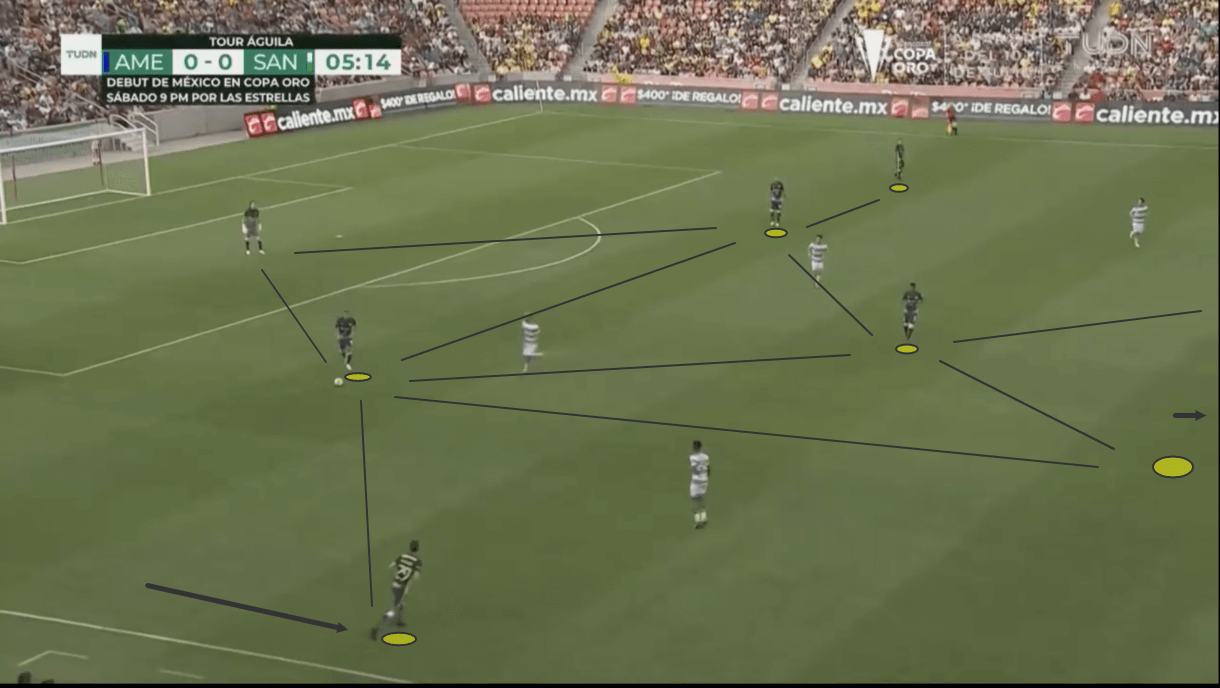
Solari’s Club América often dominate possession. They’re happy to concede the majority of possession and play more transitionally depending on the opposition but usually they are the stronger team on the pitch and thus end up with the majority of the ball. Las Águilas don’t exclusively play out via short passes from the back – sometimes they go long from the goalkeeper and are comfortable doing so – however, they do play out from the back via short passes a lot. When they do build up from the goalkeeper with short passes, they often appear as they look in figure 1.
Perhaps the most notable part of their setup here is how one full-back pushes high – essentially joining the same line as the holding midfielder – usually Pedro Aquino – while the other full-back sits deeper, remaining in the backline. It’s been common to see Solari’s Las Águilas side shape up like this with the full-backs staggered during the build-up. The deeper full-back tends to form a back three, providing extra cover in case of a dangerous turnover and subsequent opposition counter-attack while the other full-back is given freedom to venture forward.
When building out short from the back, Club América’s goalkeeper will typically find one of the two centre-backs either side of him with a short pass. Then, the near-sided full-back will advance with the full-back on the opposite side remaining deep. Figure 1 provides an example of this.
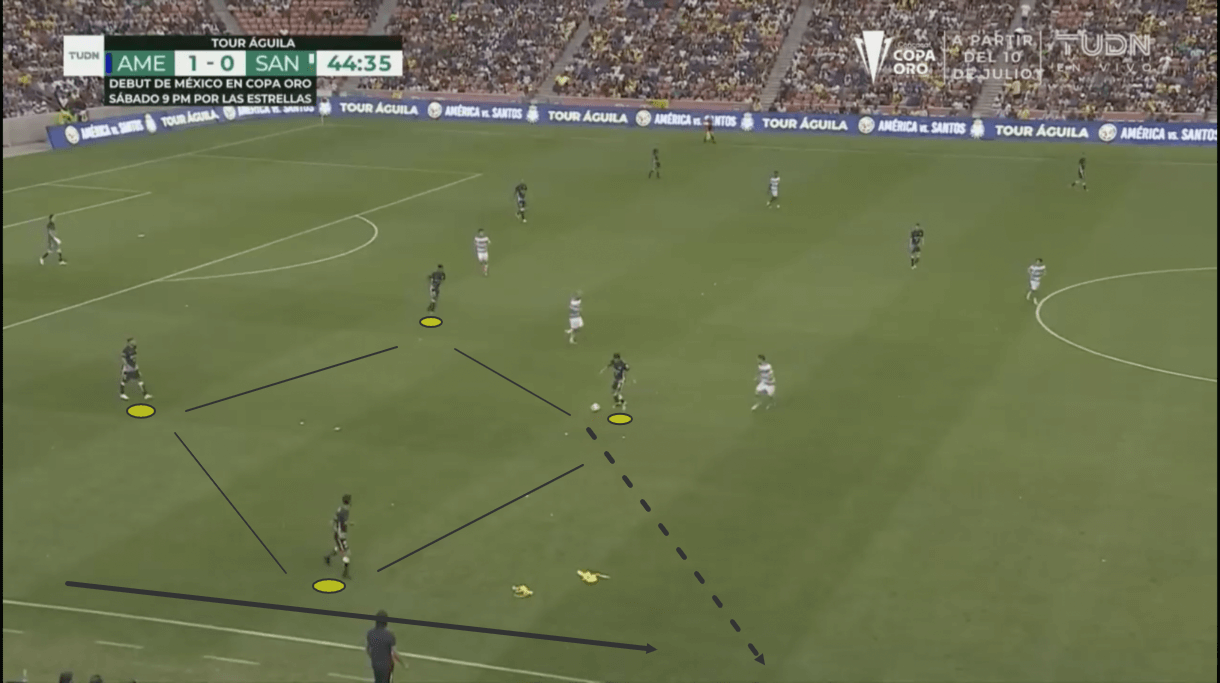
The positioning of Club América’s centre-back, holding midfielder, full-back and near-sided central midfielder creates a rhombus/diamond shape which generally gives all four players a lot of easy, natural short passing options. We see an example of this shape in figure 2. Just before this image, the right centre-back found the right central midfielder with a forward pass. The right central midfielder managed to turn before attracting too much pressure and subsequently played a through ball to the advancing right-back who could then progress the play into the opposition’s half.
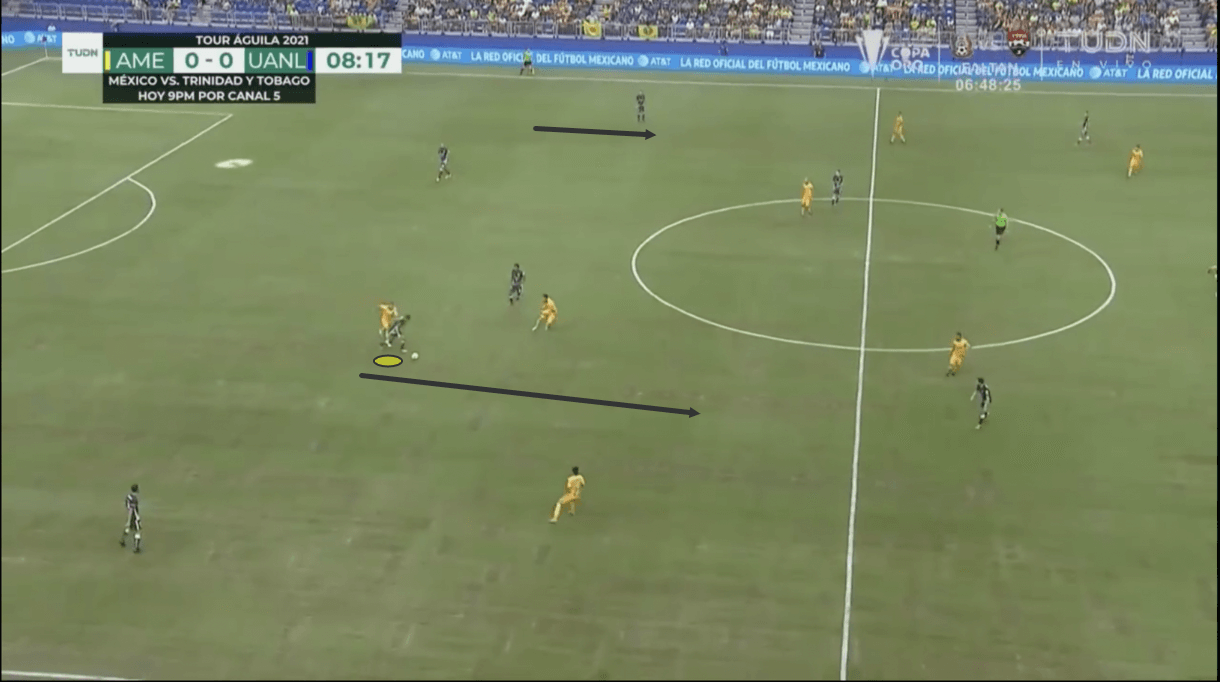
Sometimes, Club América’s centre-backs back their solo ability on the ball and opt to carry possession beyond the opposition’s first defensive line alone. We see an example of this in figure 3, where right centre-back Bruno Valdez has just attracted pressure from Tigres UANL’s centre-forward and baited him into a challenge before knocking the ball past him, skipping over the challenge and carrying the ball upfield. Valdez, in particular, often takes it upon himself to drive his team upfield via his ball-carrying ability.
One reason that it’s common for Las Águilas’ centre-backs to carry the ball upfield alone is that holding midfielder Aquino is often too safe in possession. He isn’t the most creative player and struggles with playing line-breaking passes. Additionally, Aquino is not amazing under pressure and can be put off from playing line-breaking passes relatively easily. This limitation of his on the ball is a notable weakness in Solari’s Club América side. Aquino typically ends up playing a lot of backwards passes as a result. So, Aquino is sometimes used as a decoy by Club América’s centre-backs who opt to drive upfield and progress play for their side on their own instead.
When passing out from the back, Solari’s side tend to utilise a lot of one/two-touch passing. It’s common to see the backline and midfield line restrict themselves to just one/two touches during the build-up to evade the opposition’s high press. The more comfortable and confident these deep-lying players are on the ball, the better this strategy works in terms of ball progression.
Sometimes, when players like Aquino are given the ball in these situations where the opposition are pressing aggressively, it leads to the ball being played right back to the goalkeeper. The opposition can take advantage of this by pushing up and closing off all of the goalkeeper’s simple passing options, forcing him into a rushed long ball which can result in a turnover. On other occasions, however, the benefits of Solari’s side’s quick short passing in the build-up are evident.
For example, when it works, Club América can draw multiple opposition players upfield while still finding free men in space during the build-up. As these opposition players get drawn upfield, it can create space for Club América players in more advanced positions and Las Águilas can take advantage of this space via intelligent forward passes. Then, they can put the opposition on the back foot. This would be far more effective if Club América’s deeper players were technically better, however, and Solari’s men are sometimes vulnerable to high pressure.
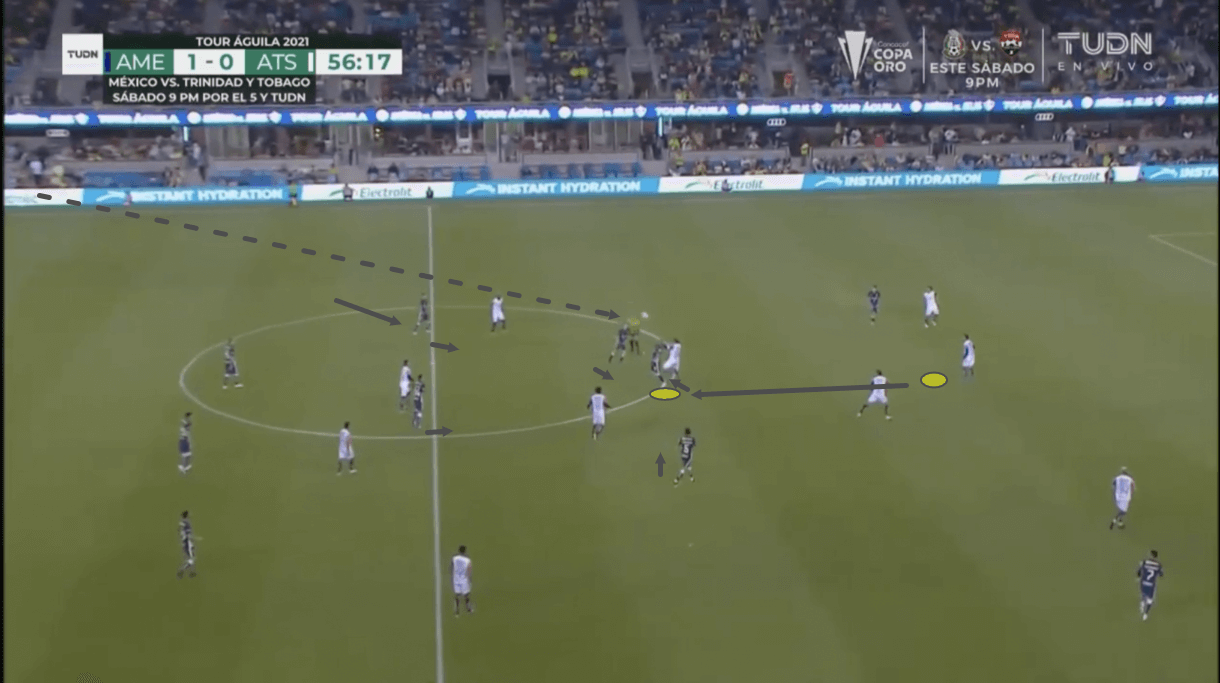
However, as mentioned previously, Solari’s side doesn’t exclusively build out from the back via short passes. They also go long from the goalkeeper quite a bit and when they do this, their shape tends to look similar to how we see it in figure 4. Similar to when building up with short passes, one full-back will advance higher, into the same line as the holding midfielder, when Club América go long from a goal kick. However, in these situations, Club América’s shape, in general, is far more narrow and compact, so the full-back essentially becomes a second holding midfielder.
Club América’s long-balls from the back tend to be aimed towards the centre-forward. Solari likes a quick, observant, and aerially proficient player in this position, with varied movement – sometimes offering an option for through passes in behind the opposition’s backline and sometimes dropping deep to create space for others to run in behind. He also likes this player to make himself available for long balls from the back, which we see an example of in figure 4, where the centre-forward has dropped in between the two central midfielders to contest the aerial duel resulting from a goal kick.
In this scenario, Solari wants his side to be positioned to press aggressively to try and win the second ball before then quickly breaking away to attack the opposition’s goal. This, along with protection of the centre in case they lose possession here, is one reason why the full-back advances, adding an extra body into central midfield. He is closer to his central teammates and the site of this aerial duel so he can help his side by pressing aggressively in a compact shape to win the second ball.
The entire Club América shape is narrow with players positioned near each other to compete for the second ball. The holding midfielders and central midfielders form a central square around the centre-forward, while the two wingers get ready for the possibility that the centre-forward flicks the ball on with his head, giving them something to chase further up the pitch. This leads to the scene we see in figure 4 being a fairly common sight in Club América’s games under Solari.
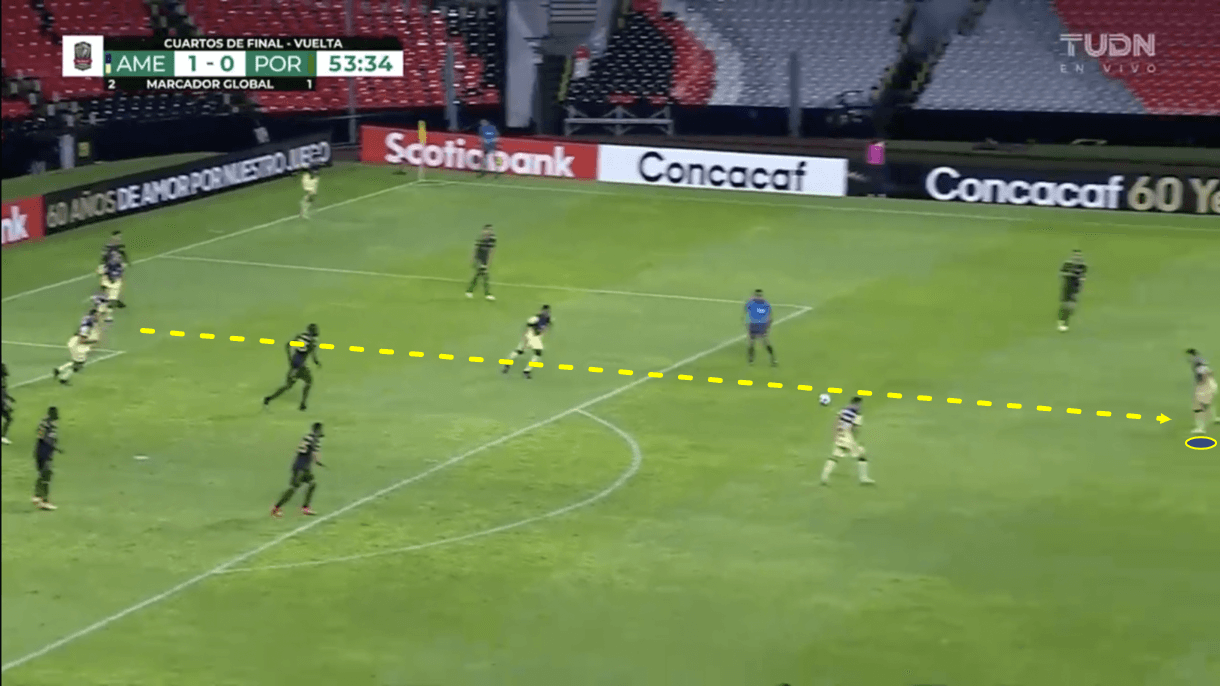
As a result of their struggles in build-up at times, Club América have arguably been more impactful on the counter under Solari. The two ‘8s’ in front of the holding midfielder have been key in several phases of play during Solari’s tenure. They’ve arguably been the most important players in the Argentinian coach’s team. We already saw a glimpse of their role in the build-up back in figure 2 when we looked at how they form the tip of Club América’s wide diamond in the build-up. Now, in figure 5, we’ll see how the two ‘8s’ in Solari’s system play a key role in the transition to attack.
Just before the image above, Club América were defending deep inside their own box. After regaining possession, the centre-back got his head up and immediately sent the ball forward to the left central midfielder, who has dropped and made himself available for this pass. In regular build-up phases, Club América sometimes struggle to get the ball to these players as the opposition will be marking them/blocking the passing lanes to them in a more organised defensive shape. However, the transition allows Club América to hit their opponents on the counter when they are less organised and thus, more vulnerable.
In figure 5, we see how Club América take advantage of this less organised opposition shape by immediately finding the ‘8’, who, as mentioned previously, plays a key role in virtually every phase of play in Solari’s system, including build-up and ball progression.
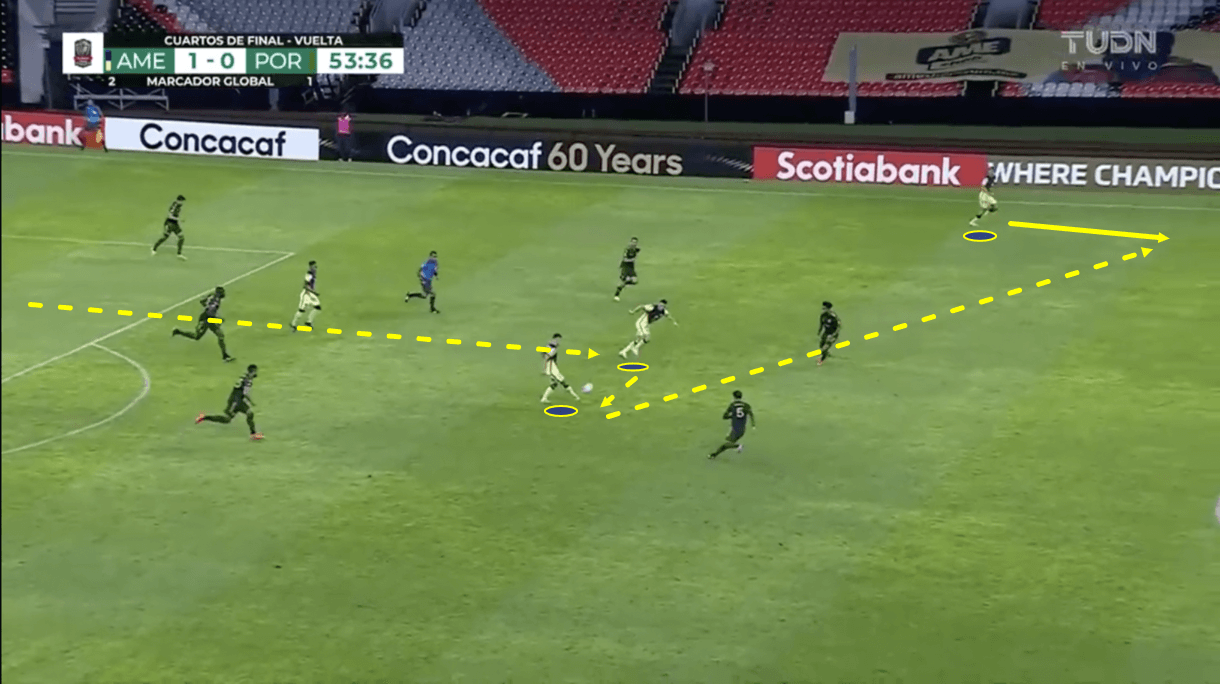
As this passage of play moves on into figure 6, we see how the ‘8’ linked up with the holding midfielder beside him – laying the ball off to him while turning. The holding midfielder could then receive the ball while facing forward, not needing to turn, making it easier for him to play a forward pass. This, combined with the left-back’s surging forward run and the holding midfielder’s eventual accurate pass, set Club América off on a dangerous counter-attack.
This passage of play highlights how counter-attacks allow Club América to find the pivotal ‘8s’ more easily and allow them to slice through the opposition’s defensive shape far more easily than when building up more regularly.
Chance creation
In general, Club América rely on the wingers and ‘8s’ to carry the ball forward and pick out passes for the final ball to breach the opposition’s backline and set up a goalscoring chance or carry the ball into a position from where they can take a shot themselves. One noteworthy thing about Solari’s Club América in the final third is that they don’t like to waste time in the final third. They’re an aggressive side and they’re also quite impatient at times. As a result, they do snatch at opportunities on occasion and when a clear backline-splitting ball isn’t apparent, the wingers and ‘8s’ do tend to take on long shots to varying degrees of success.
This may be another reason why this team always seem so comfortable in transition. Again, the opposition’s backline will be less organised when defending against a counter, and so it can be easier for Club América to play through them compared to when they’re creating a chance via a positional attack against an organised opposition low block which requires more patience and precision in the final third. Solari’s side could benefit from more patience to create better-quality chances. However, Las Águilas have demonstrated some clear tactical traits in the final third during Solari’s tenure to break the opposition down.
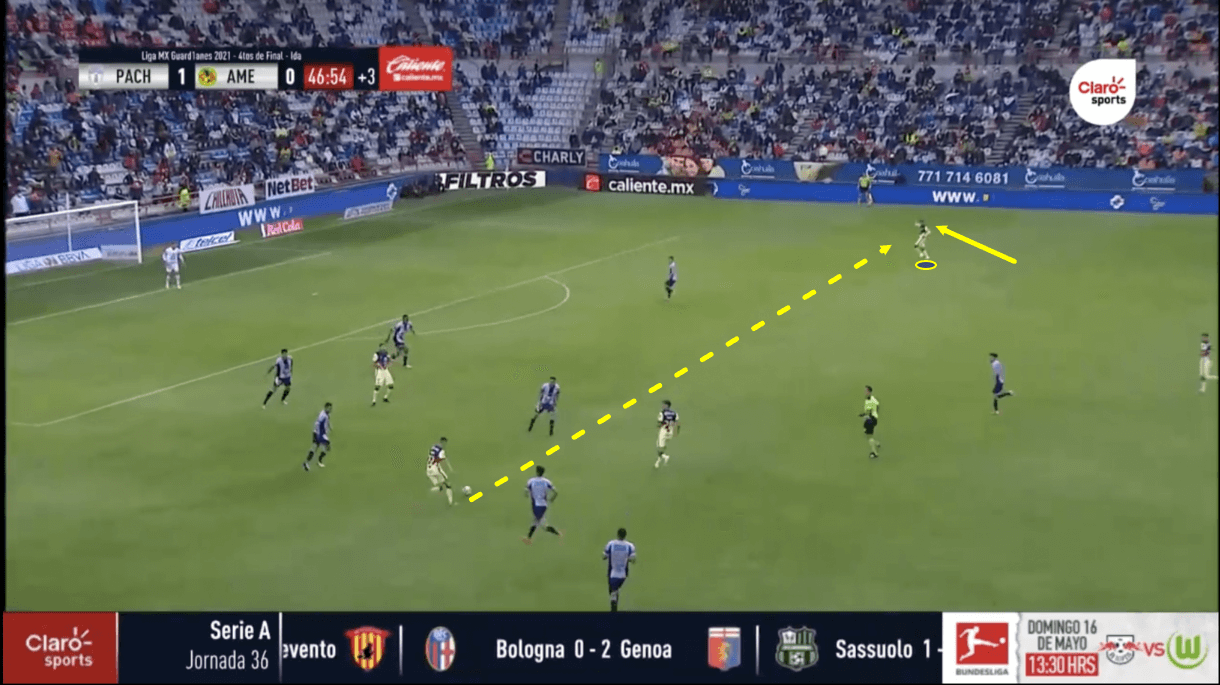
Firstly, in figure 7, we see an example of Club América’s left-winger switching play to the opposite side of the pitch, finding his right-wing teammate. Again, Solari’s Las Águilas side aren’t incredibly patient in the final third and in general, after a pass like this, you would expect the right-winger to either cross quite quickly or dribble inside to create an immediate playmaking/goalscoring chance. In this team, you wouldn’t expect him to continue passing the ball intricately to carefully carve an opening via smart, patient positional play. This is a stylistic choice, more than anything, but one that’s worth noting about Solari’s side.
However, it’s quite common to see Las Águilas play this switch in the final third under Solari to exploit an underloaded wing. Club América will attract opposition players to one wing, in this case – the left – via some quick short passing, dribbling and intelligent, dangerous positioning of players on this side. As the opposition’s defensive shape shifts over as a unit to secure this side more heavily, preventing gaps from being exploited in their defensive shape, Club América’s winger on the other side holds the width and tries to take advantage of the underload.
The Mexico City-based club are well prepared for these situations and are always on the lookout for opportunities to exploit an underloaded wing via a switch in the final third like the one we see in figure 7. This often creates a favourable situation in the final third for the winger who can take on the opposition full-back 1v1 and potentially exploit a qualitative advantage.
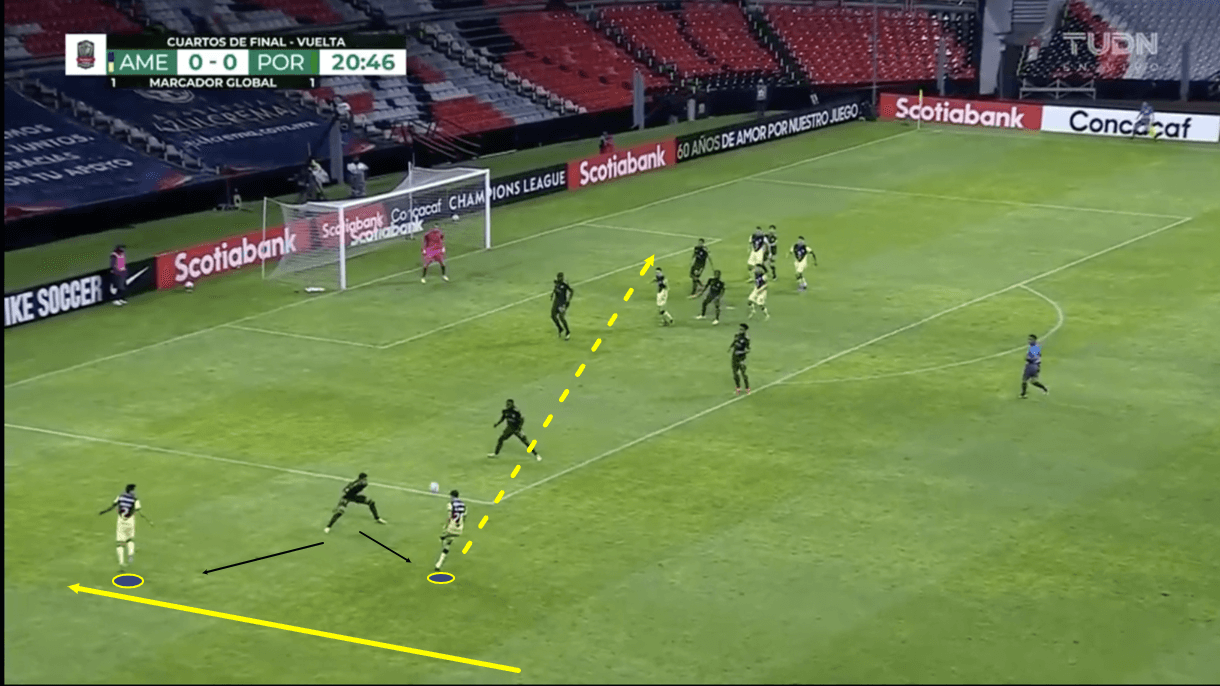
Sometimes, rather than a qualitative advantage, Solari’s Club América side create quick but effective quantitative advantages versus the opposition full-back inside the final third in the form of a double-up on the opposition full-back with Solari’s full-back advancing and supporting the winger to create a 2v1 as we see in figure 8.
Just before this image, the ball was crossed into the box from the opposite wing but it ended up falling to the left-winger. As the opposition right-back confronted this winger, Club América’s left-back overlapped to give that opposition right-back two men to worry about – not just one. As the defender was caught in two minds, Club América’s left-winger enjoyed more space and could pick out his cross more easily to set up a goalscoring opportunity.
If Solari’s side were more patient in the final third, we might see them create overloads on the wing more carefully in positional attacks. However, their quick and aggressive style doesn’t allow time for this, nor does it really make this much of a necessity. Instead, it can be easier and just as effective for them to create a simple 2v1 like this versus the isolated opposition full-back to create a shooting chance. As a result, it’s common to see Club América doubling up on the opposition full-back like this, it’s clearly a deliberate part of their game at present.
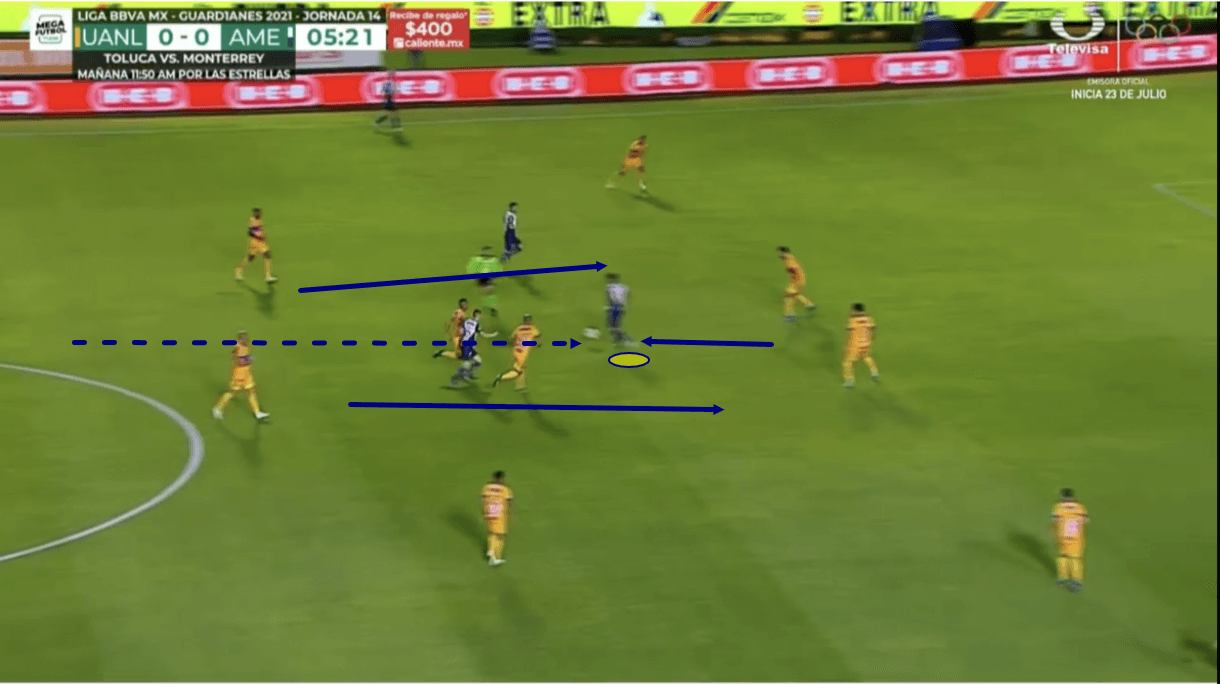
Lastly, in figure 9 we see an example of one way in which Solari’s ‘8s’ contribute in the final third. As mentioned at the beginning of this section, the ‘8s’ are responsible for carrying the ball into the final third and playmaking positions. They’re also required to have a good relationship and understanding with the centre-forward to link up with him and even temporarily switch positions with him as we see in figure 9.
Here, the ‘8s’ have carried possession into the opposition’s half for Club América. While continuing to carry the ball upfield, Las Águilas’ centre-forward made himself available for a pass to feet. As mentioned previously, the centre-forward in this system has to have a versatile skill set, including good, intelligent movement. He must be comfortable playing with his back to goal to link up with the ‘8s’ like this, allowing them to run beyond him before turning and playing them or possibly even the wingers out wide through to create a goalscoring chance.
As play moves on here in figure 9, we see the ‘8s’ run beyond the centre-forward who turns and quickly assesses his passing options. He enjoys plenty of time and space thanks to this little positional switch with the ‘8s’ which can leave the opposition somewhat disorganised when pulled off effectively. Meanwhile, Club América momentarily create an overload versus the opposition backline, which can be lethal if exploited effectively inside the final third. It’s common to see Club América’s ‘8s’ link up with the centre-forward like this in the chance creation phase. This type of play has created plenty of goalscoring opportunities for Solari’s side this term.
High-block
Generally speaking, Club América have been quite aggressive in their pressing under Solari thus far. This ties in well with their comfortability in moments of transition. It’s common to see Solari’s side pressing high to try and force turnovers and exploit the opposition’s unprepared backline via a quick counter-attack from a dangerous position.
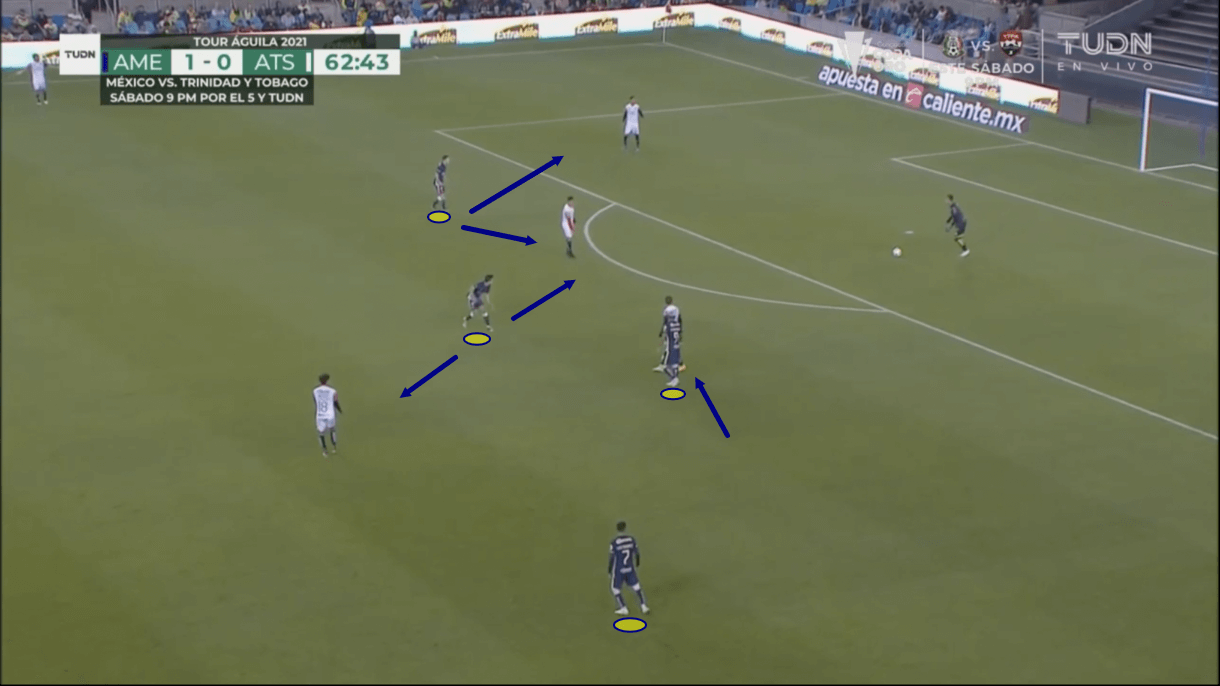
In figure 10, we see an example of Club América’s defensive positioning during the high block phase. Here, we see their centre-forward sitting on one opposition defender in the central position nearest to the camera, while two of Club América’s central midfielders are also pictured in what is essentially a makeshift ‘front three’ to combat the opposition’s three-man backline in build-up. Meanwhile, Solari’s wingers tend to sit deeper and wider, protecting the wide midfield areas and readying themselves to press the opposition full-backs immediately should they receive possession in the build-up.
Solari’s side are very aware of opposition attempts to outnumber their attackers with the backline in the build-up and try to guard against this through the positioning of their attackers. It’s common to see them add numbers to the front line from midfield if necessary, as we see here, to cover all of the opposition’s backline, making it more difficult for them to play out from the back.
Additionally, it’s worth noting how the central player in Club América’s makeshift front three here is somewhat caught in two minds about which player to mark, as one more advanced opposition player moves into the centre to exploit space that Solari’s ‘8s’ vacated to mark the deeper players. Ultimately, this player ends up moving closer to the deeper opposition player, allowing the more advanced one more space to potentially receive possession. This is one way in which Club América take risks while pressing and can be exploited by the opposition. However, it’s a risk they’re willing to take to prevent the opposition from overloading their first line.
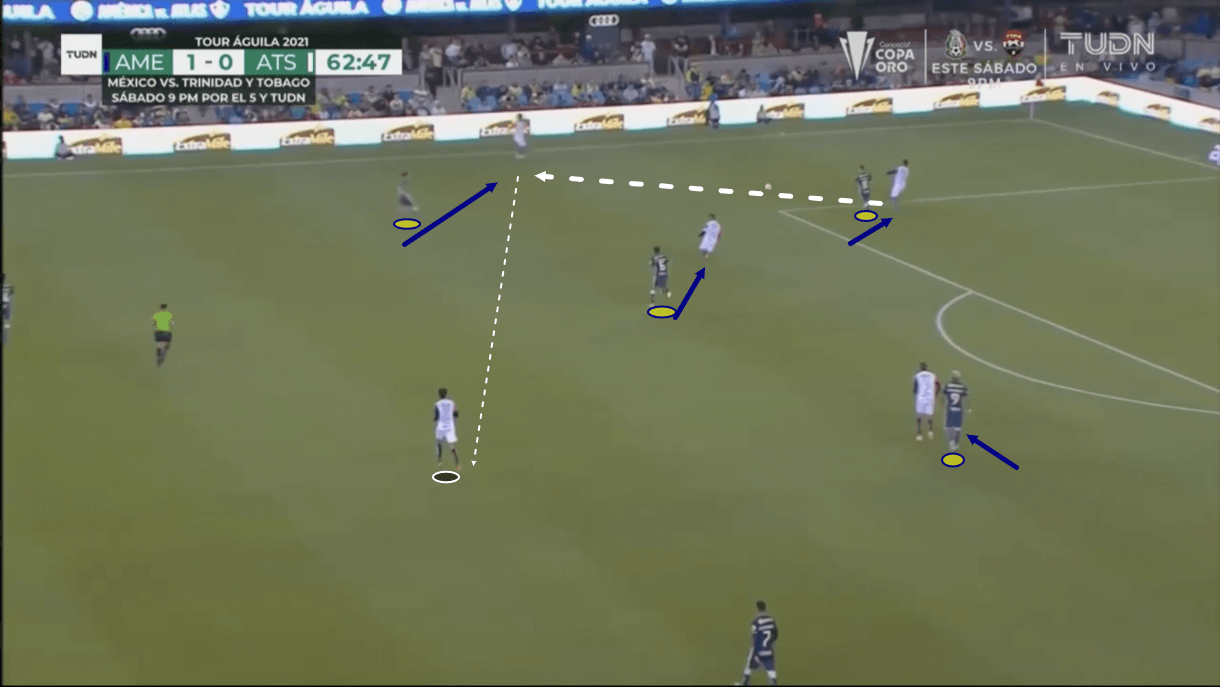
As this passage of play moves on into figure 11, the opposition’s goalkeeper ultimately opts to pass short to the right centre-back. With the other members of the backline being marked tightly and amid aggressive pressure from the Club América central midfielder assigned to him, play is forced out to the right-back as we see in this image. This pass attracts even more pressure from Club América, who remain tight to the opposition’s backline.
As the ball is played out to the right-back, Club América’s left-winger springs into action and closes him down aggressively, cutting off the passing lane into the free, more advanced central midfielder. As explained earlier, Solari’s men allowed this player to be relatively free so they could mark the deeper players more tightly. The opposition did well to almost create an opportunity to pass into this player and really hurt Las Águilas, however, the aggressive pressure from Solari’s side came up trumps in the end as they closed down the ball-receiver, cut off this passing lane and forced the opposition into an unfavourable situation where a rushed, inaccurate long ball could be the best option to avoid a deep turnover in a dangerous position.
This passage of play highlights how Solari’s Club América defend in the high block. The players are very aggressive, orienting themselves to the opposition’s deepest passing options. They back the quality of their press to prevent these aggressive tactics from being exploited. Of course, it’s sometimes unavoidable that these tactics will be exploited by quick, intelligent opposition passing, but they deem the reward to be greater than the risk, which is difficult to argue with considering how well they perform in moments of transition. An instance of effective high pressure could lead to their best chance of a given game – this is arguably when they are at their most dangerous.
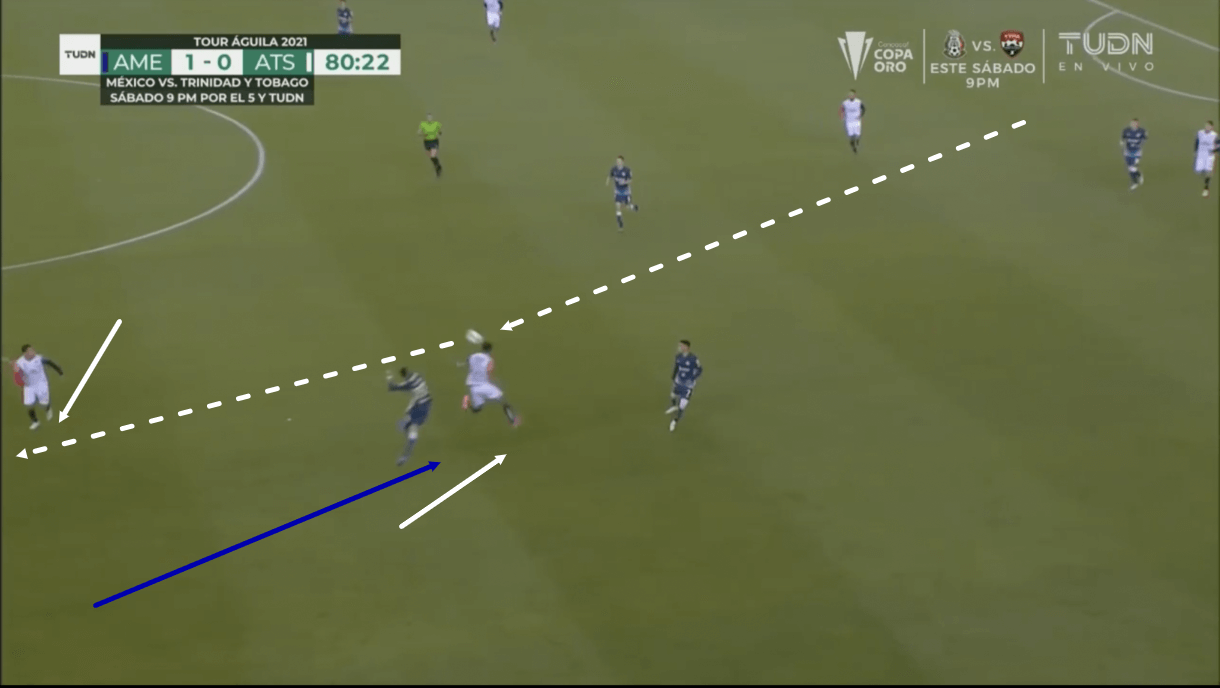
One way in which this pressing can be exploited was highlighted in this same game analysed in figures 10 and 11, however. Firstly, though somewhat obvious, it’s worth stating that with committing numbers upfield into advanced, aggressive defensive positions, Club América weaken themselves numerically in deeper positions. This can then be exploited by long balls from the opposition, which was the case in the passage of play beginning with figure 12. Here, we see the opposition winning an aerial duel via a flick-on resulting from the long goal kick.
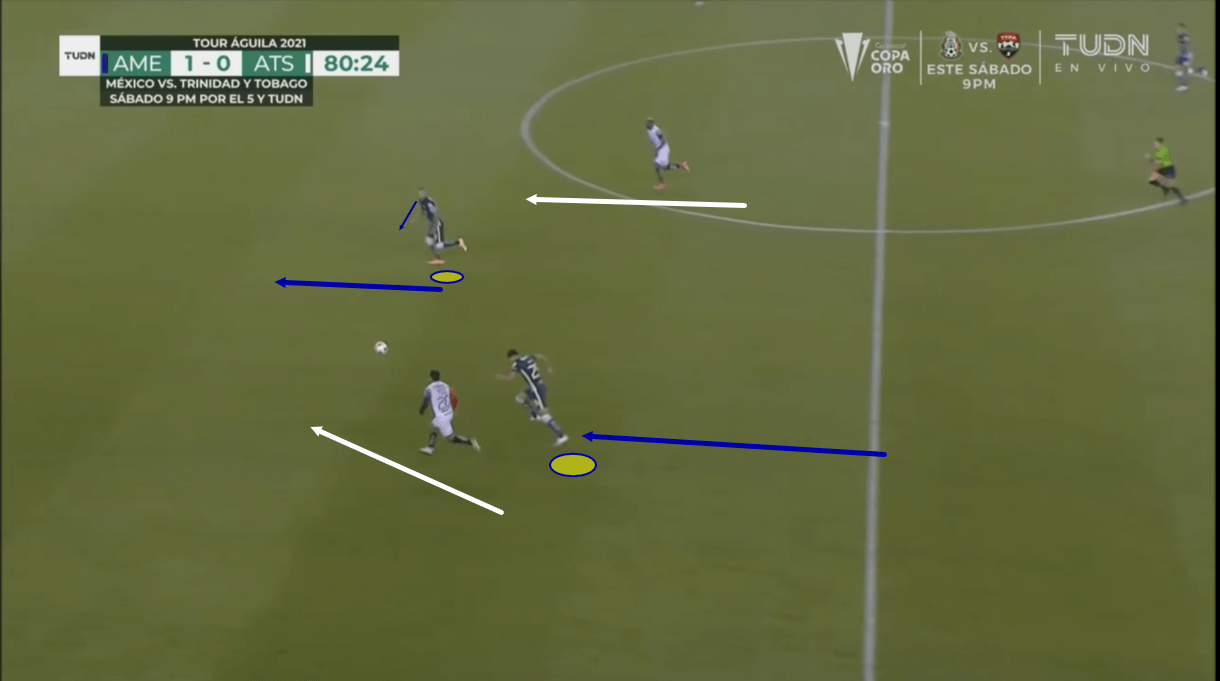
Then, as play moves on into figure 13, an opposition runner manages to get onto the end of that flick-on and with so many Club América bodies upfield, they create a very quick and effective overload against Solari’s backline. Leaving free bodies in more advanced positions does have its risks, some of which is evident from this passage of play. It can lead to the opposition creating simple, quick overloads which can be deadly.
So, it’s just necessary for Solari’s side to be aware of these risks. In general, the more advanced, aggressive defenders will try to close down the opposition ball-carriers and prevent these long-balls from being played but from goal-kicks especially, this type of scenario is one major way in which Solari’s aggressive high press can be exploited effectively, along with quick short passing in the build-up to forge openings into free midfielders.
Mid-block and low-block
When defending deeper, it’s common to see Solari’s Club América side drop into a 4-5-1 shape. The centre-forward will typically sit higher, providing an outlet for the deeper players to use should they regain possession and create a counter-attacking opportunity, while the back-four gets quite compact to protect the centre in this advanced area and the midfield five stretch across the centre to protect this area.
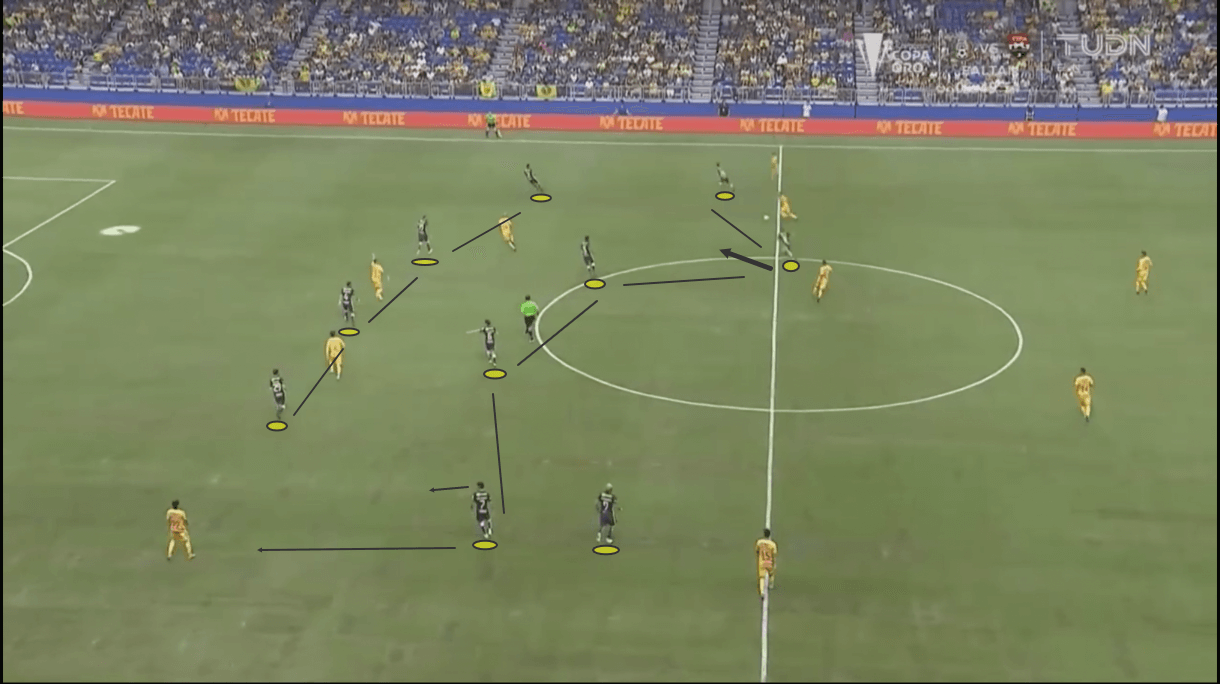
Figure 14 shows us an example of this defensive shape in the mid-block phase. As the opposition progress to this point, Club América’s players drop into a deeper shape, as seen above, and defend far less aggressively. They will put pressure on the opposition ball-carriers, but won’t mark passing options as aggressively, instead protecting their respective zones.
Due to how narrow and compact Club América’s backline gets, the wingers are often forced to drop into the backline to offer extra protection out wide. We see an example of this in figure 14, where an opposition player is enjoying a lot of space on the left wing, which attracts attention from Club América’s right-winger. As play moves on, we see this player drop into the backline. This is one drawback of Club América’s narrow backline. Yes, it protects central areas better which must be the priority but it allows too much space to open up on the wings.
As this ultimately forces the wingers into the backline, Club América often end up with a back-six when moving into the low-block phase, which can be effective at preventing gaps from opening/being exploited in very advanced areas but allows a lot of space to open up in not-very-deep positions for the opposition to take advantage of in the chance creation phase.
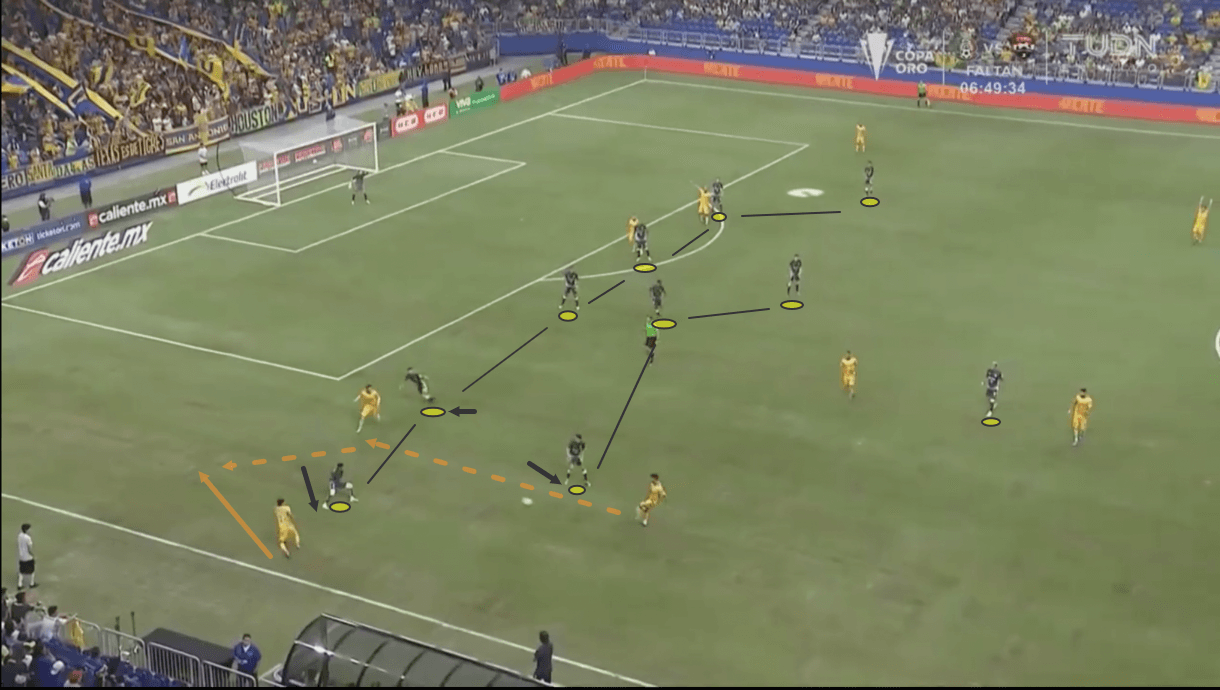
Take figure 15, for example. Here, we can see Club América’s 6-3-1 in the low-block phase, with the wingers having been forced into the backline to protect the wings. This leaves Solari’s side with a three-man midfield line which isn’t ideal for protecting the width in this area on the outskirts of the final third. Additionally, Club América’s backline tends to defend quite aggressively in the low block. We see this in figure 15, where the right-winger has been drawn out to mark the opposition’s left-sided wide man closely and the right-back is marking the opposition player in the half-space closely. Due to this aggressive marking from Club América’s backline, the opposition can manipulate their positioning to aid with chance creation.
As this passage of play moves on, we see the deeper playmaker enjoy time to pick out a creative pass into the half-space because of the lack of width in Club América’s three-man midfield, while the two advanced opposition attackers on this wing make alternating movements to receive this pass and exploit space in behind via a pass and run combination to break through Club América’s six-man backline.
So, while Club América’s six-man backline in the low-block phase sounds like a difficult obstacle to overcome on paper, and has proven to be quite effective at stifling opposition attacks during Solari’s tenure, if they are forced to drop into this shape it isn’t entirely safe. It does allow space to form in the now-weakened midfield line and due to the aggressive marking in the backline, the opposition can manipulate their positioning and exploit them via quick movement and creative passing in the final third as we saw in figure 15. Like with patient vs aggressive attacking, Solari’s Las Águilas side tend to perform better in scenarios where aggressive defending is king, as opposed to patient defending.
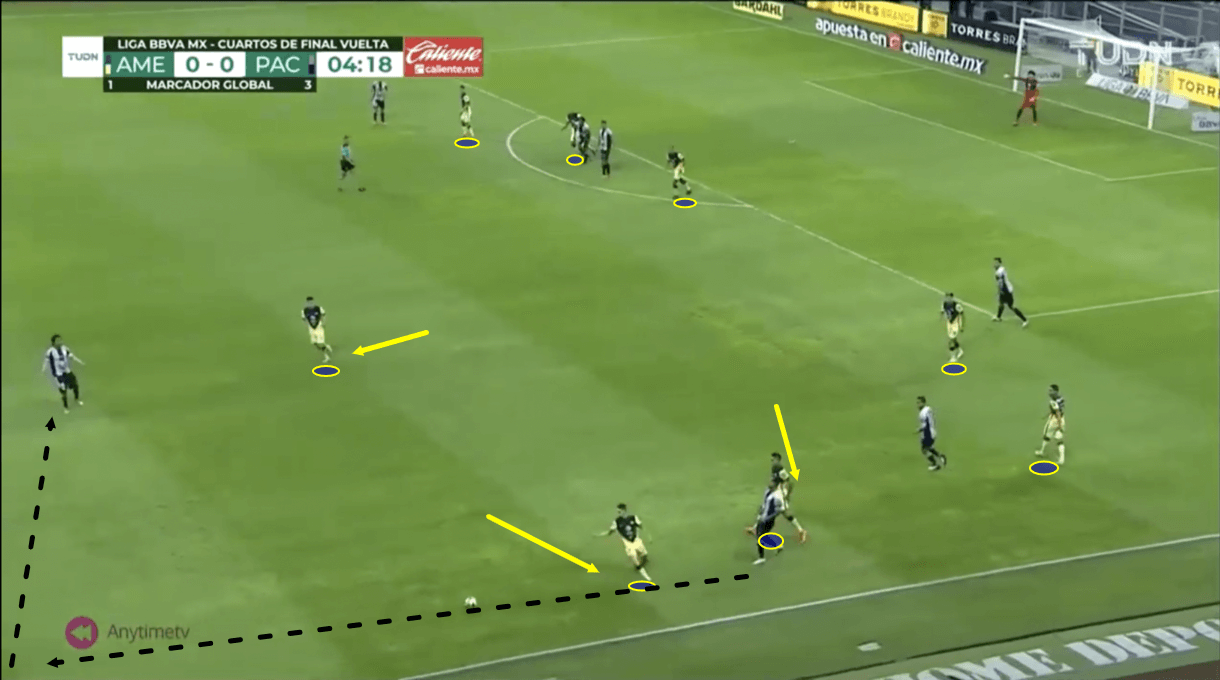
Quick switches of play can also lead to Club América’s lack of width being exploited in the final third. We see an example of this in the passage of play beginning with figure 16. Here, we see how Las Águilas’ opponents attracted their defensive shape to the right-wing via intelligent positioning and careful passing plays, taking advantage of Club América’s tendency to defend aggressively. Then, the ball was played backwards before being sent into midfield.
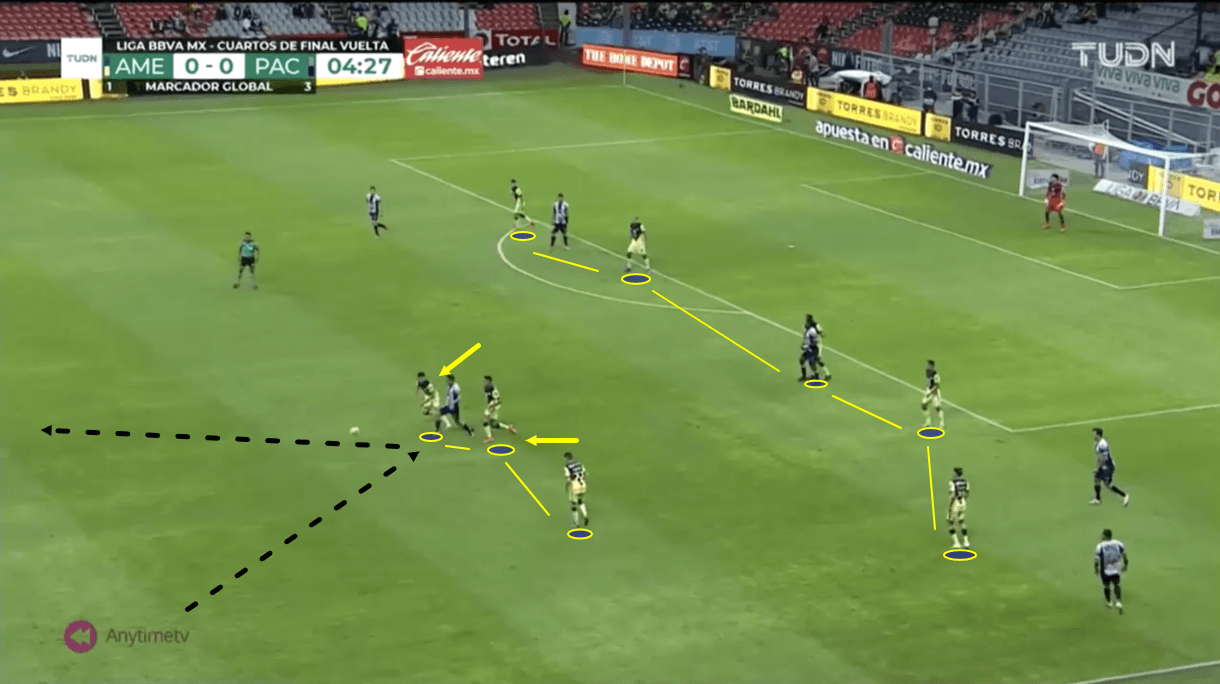
As the ball is played into midfield, Club América’s midfielders will tend to try and gather around the ball-receiver, sticking closely and regain possession by quickly closing in on this central player. We see an example of this in figure 17. However, in this example, the central player was quick-thinking and released the ball before Club América’s press put a stop to this attack. Again, sending the ball back to move forwards.
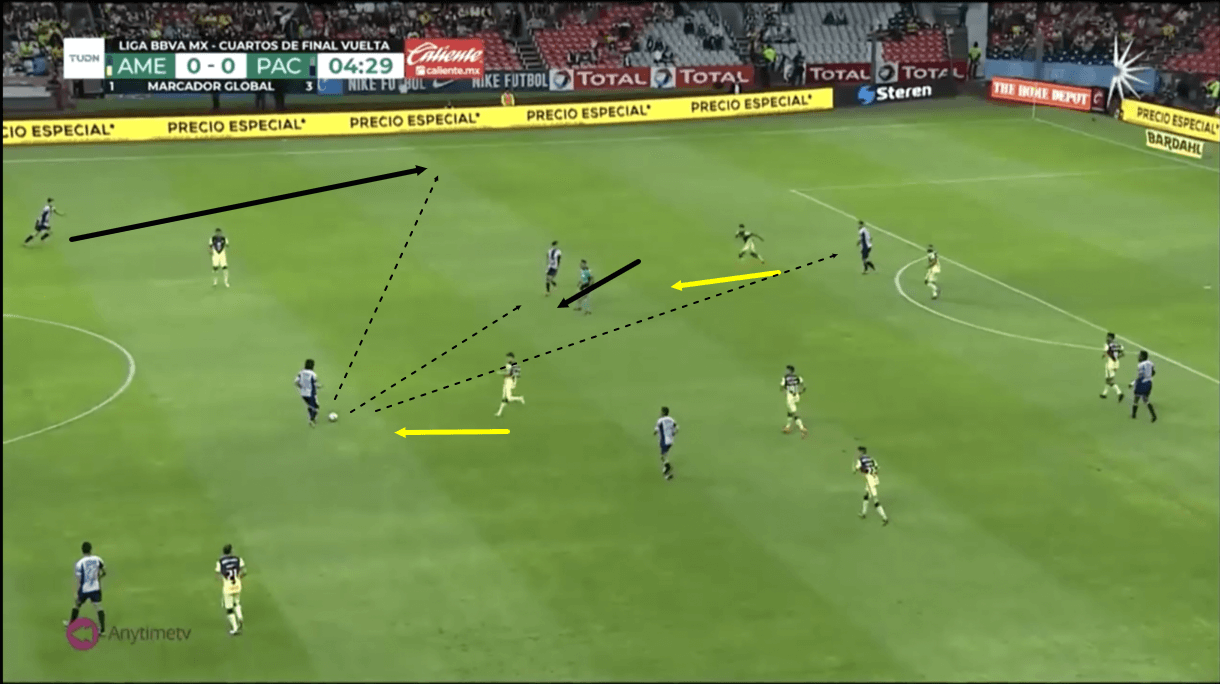
Lastly, we see the scenario shown in figure 18, where a deep-lying central midfielder has time and space on the ball to pick out a relatively simple, creative pass towards the underloaded wing. We see an opposition full-back driving forwards into space on this wing, one opposition player moving from the half-space into the centre to receive a short pass which attracts pressure from a member of the opposition backline who defends aggressively to try and cut off this passing option, allowing space for a more advanced opposition player to run in behind and offer a third potential passing option to the man on the ball.
So, we see how quick, short passing moves, once again, just like in the build-up, can exploit Club América’s defensive tactics. Their aggressive tendencies, as well as their narrow defensive shape in the low-block phase, can be exploited by intelligent opposition attacks.
That said, their defensive record is certainly not terrible under Solari. These tactics can work well too. While the aggressive defending can allow gaps to open in the backline as we see in figure 18, it can also prevent opposition players from enjoying too much space and can cut off creative passing options. While dropping the wingers into the backline can lead to the midfield line being too narrow to protect the wings, it can also make it very difficult for the opposition to find gaps they can exploit in the final third. The positives have been true far more than the negatives for Las Águilas under Solari, so this section isn’t to say that they defend poorly, rather it’s just to point out some potential areas of concern moving forward and areas to target for opposition sides.
Conclusion
To conclude our tactical analysis piece, Solari’s Club América side have demonstrated some interesting ideas in the build-up phase – though they’re sometimes limited by their holding midfielder’s capability on the ball so that’s an area to work on for Solari and his coaching staff – and they tend to perform very well, in terms of chance creation and ball progression, in moments of transition.
Solari’s side prefer to play aggressively, with a high tempo and do snatch at chances on occasion as a result, but can also play some quick, exciting football in attack because of this stylistic tendency. Additionally, they tend to defend better when defending aggressively, in the high-block, compared to when defending in the mid-block/low-block when they must be more patient and are sometimes punished for their aggression. However, these tactics have helped Solari to get his side into the CONCACAF Champions League semi-finals and if they manage to go all the way in this tournament, then it may be difficult to argue that the former Real Madrid man’s tactics haven’t “matched the greatness” of the North American giants.





Comments